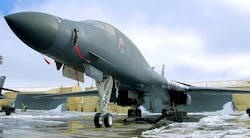Air Force considering AESA radar upgrades for B-1 and B-52 strategic bomber fleets
WRIGHT-PATTERSON AFB, Ohio, 11 March 2014. U.S. Air Force bomber experts are considering upgrading the Air Force fleet of B-1 Lancer and B-52 Stratofortress long-range jet bombers with active electronically scanned array (AESA) radar systems to improve bomber surveillance and targeting capability.
AESA radars aim their beam by emitting separate radio waves interfering constructively at certain angles off the antenna, Air Force officials say. With this technology change, Air Force bomber experts are trying to preserve current system radar modes.
Although no formal avionics upgrade program to outfit B-1s and B-52 with AESA radar is in place, officials of the Air Force Fighters/Bombers Directorate of the Air Force Life Cycle Management Center (AFLCMC) and the Air Force Research Laboratory (AFRL) at Wright-Patterson Air Force Base, Ohio, have asked for industry information and recommendations on potential bomber radar upgrades.
Air Force bomber experts are asking industry for information about relevant internal research and development projects that might be related to bomber radar upgrades.
Information gathered from industry will go to the Air Force Air Force Fighters/Bombers Directorate, as well as to the B-1 and B-52 system program offices, to the Air Force Life Cycle Management Center's Capabilities Integration staff, to the Air Force's Internal Research and Development Program Office, and to several Technology Directorates of the Air Force Research Lab.
A team from these Air Force organizations plan to choose relevant projects from companies for further discussions on upgrading B-1 and B-52 bombers with AESA radar technology.
Related: Air Force to turn over 0.14-micron MMIC technology to industry for advanced radar
For potential B-1 AESA radar upgrades, Air Force officials are interested in circular-polarization (rain rejection); plus-or-minus 120 degree field of view; maritime capability; high reliability; modern open systems architecture for a multi-band emitter; high-resolution synthetic aperture radar mapping capability; bandwidth within current system range; and affordability.
For potential B-52 AESA radar upgrades officials are interested in nuclear-hardened survivability; plus-or-minus 120 degree field of view; maritime capability; high reliability; modern open systems architectures; data link capability; bandwidth within X-band; and affordability.
For suggestions or questions phone the Air Force's Lee Gray at 937-713-7563, or Dan Turner at 937-255-3812. More information is online at https://www.fbo.gov/spg/USAF/AFMC/AFRL-PK/AFRL-XP-14-0005/listing.html.

